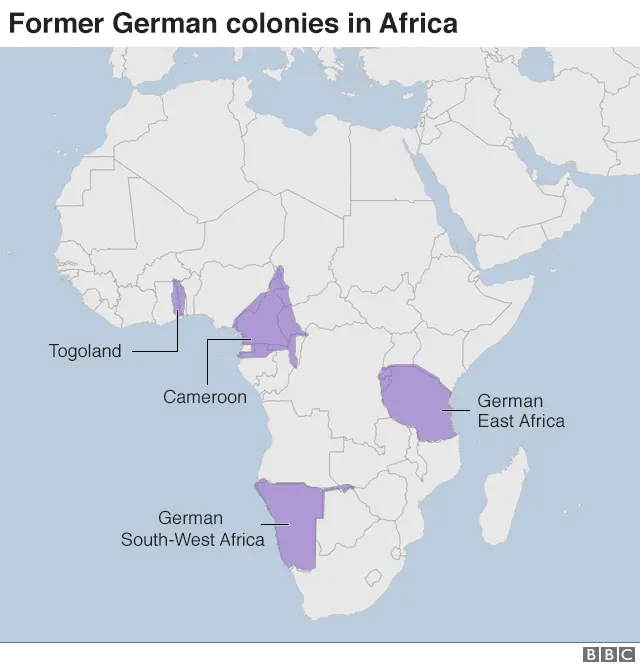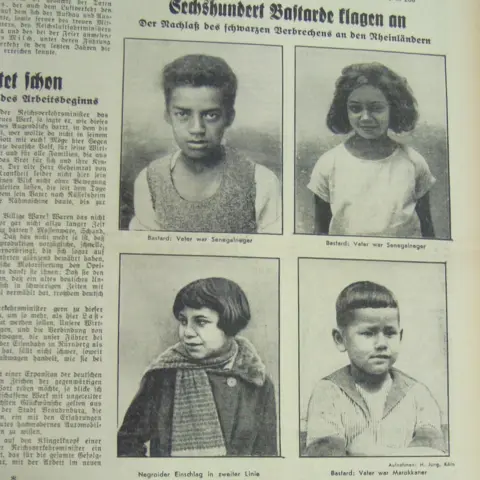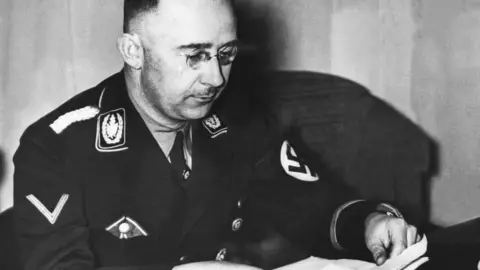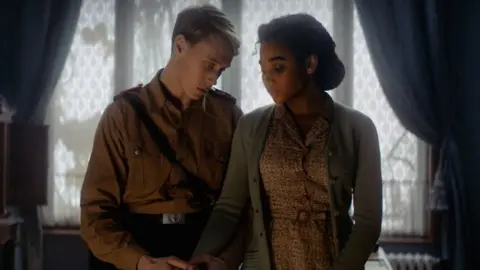Being black in Nazi Germany
 Library of Congress
Library of Congress
Film director Amma Asante came across an old photograph taken in Nazi Germany of a black schoolgirl by chance.
Standing among her white classmates, who stare straight into the camera, she enigmatically glances to the side.
Curiosity about the photograph - who the girl was and what she was doing in Germany - set the award-winning film-maker off on a path that led to Where Hands Touch, a new movie starring Amandla Stenberg and George MacKay.
It is an imagined account of a mixed-race teenager's clandestine relationship with a Hitler Youth member, but it is based on historical record.
Warning: Some people may find some of the content of this article upsetting
In the Nazi era, from 1933 to 1945, African-Germans numbered in their thousands.
There was no uniform experience, but over time, they were banned from having relationships with white people, excluded from education and types of employment, and some were sterilised, while others were taken to concentration camps.
'Disbelief and dismissiveness'
But their story has largely been untold - and it has taken Ms Asante 12 years to get her account of the period on to the big screen.
 Spirit Entertainment
Spirit Entertainment"Often there's a form of disbelief, of questioning, sometimes even a dismissiveness of the difficult lives these people led," she told the BBC about the reaction she received from some when she spoke about her research for the film.
The African-German community has its origins in the country's short-lived empire. Sailors, servants, students and entertainers from present-day Cameroon, Togo, Tanzania, Rwanda, Burundi and Namibia came to Germany.


Once World War One broke out in 1914 this transient population became more settled, according to historian Robbie Aitken. And some African soldiers who fought for Germany in the war also settled there.
But there was a second group whose presence went on to feed into the Nazis' fear of racial mixing.
As part of the treaty that was signed after Germany's defeat in World War One, French troops occupied the Rhineland area of western Germany.
France used at least 20,000 soldiers from its African empire, mainly North and West Africa, to police the area, some of whom went on to have relationships with German women.
Racist caricatures
The derogatory term "Rhineland bastards" was coined in the 1920s to refer to the 600-800 mixed-race children who were the result of those relationships.
The term spoke to some people's imagined fears of an impure race. Made-up stories and racist caricatures of sexually predatory African soldiers were circulated at the time, fuelling concern.
 Robbie Aitken
Robbie Aitken
While anti-Semitism occupied a pre-eminent place at the heart of Nazi ideology, a line in Mein Kampf, the book published in 1925 outlining the political beliefs of party leader Adolf Hitler, linked Jewish and black people.
"It was and is the Jews who bring the Negroes into the Rhineland," Hitler wrote, "always with the same secret thought and clear aim of ruining the hated white race by the necessarily resulting bastardisation."
Once in power, the Nazis' obsession with Jews and racial purity gradually led to the Holocaust, the industrialised slaughter of six million Jewish people during World War Two, as well as the mass murder of Roma, people with disabilities and some of the Slavic peoples.
Mr Aitken, who researches the lives of black Germans, says they were targeted too - albeit not in the same systematic way.
He describes them as being assimilated into the Nazis' "spiralling radicalisation of racial policy".
He says evidence shows their policies toward "other 'racial aliens' hint toward a goal of racial annihilationism".
'I felt only half-human'
In 1935, the Nuremberg laws, which among other things outlawed marriages between Jews and other Germans, were passed. These were then amended to include black people and Roma in the same category as Jews.
But a fear of racial mixing persisted and in 1937 the mixed-race children from the Rhineland were targeted for forced sterilisation.
 Getty Images
Getty ImagesHans Hauck was one of at least 385 people who underwent the operation. Mr Hauck, the son of an Algerian soldier and a white German, appeared in the 1997 documentary Hitler's Forgotten Victims.
He spoke about how he was taken in secret to have a vasectomy. He was then given a sterilisation certificate, to allow him to carry on working, and he had to sign an agreement saying he would not marry or have sex with people "with German blood".
"It was depressing and oppressive," he told the documentary makers, "I felt only half-human".
Another victim, Thomas Holzhauser, said on the film: "Sometimes I'm glad I couldn't have children. At least they were spared the shame I lived with."
Very few others spoke about their experiences while they were alive, and "there have not been many attempts to uncover what eventually happened to the majority of them", Mr Aitken, who is one of the few historians working on the subject, told the BBC.
"It is worthwhile remembering that the Nazis also wilfully destroyed many of the documents pertaining to camps and to sterilisation, making it difficult to reconstruct the fates of groups and individuals," he said.
Ms Asante, who has also written and directed Belle and A United Kingdom, says many of these people suffered an identity crisis. They had a German parent and saw themselves as German, but they were also isolated and never fully embraced.
"The children were inhabiting two places at the same time. They were both insiders and outsiders," the 49-year-old said.
Though their experiences differed, all black Germans were subjected to persecution under Nazi rule.
Germany's colonial era, especially the attempted genocide of the Herero and Nama people in Namibia, already led to a negative view of Africans.

More on Germany's colonial legacy:

After Hitler came to power, they were harassed, humiliated in public, excluded from types of work and education, and essentially rendered stateless.
There was some resistance. For example, Hilarius Gilges, who was mixed race, was a Communist and anti-Nazi agitator. He was kidnapped and murdered in 1933.
Once war broke out in 1939, their position became more precarious. People in mixed relationships could be targeted for sterilisation, imprisonment or murder.
Trying to be invisible
That was the fear of Theodor Wonja Michael, who was born in Berlin in 1925 - the son of a Cameroonian man and a German woman
Growing up he appeared in so-called "human zoos", or ethnographical exhibitions, he told German broadcaster DW in 2017.
 US Holocaust Memorial Museum
US Holocaust Memorial Museum
"With vast skirts, drums, dancing and songs - the idea was that people on display were foreign, exotic and were showing spectators what their homeland was like," he said. "Basically it was just a big show."
Once the Nazis came to power he knew that he had to stay as invisible as possible, especially when he became a teenager.
"Of course, with a face like this I could never completely disappear, but I tried.
"I avoided all contact with white women. That would have been horrible. I would have been sterilised and I might also have been charged with racial defilement," he said on the DW film Afro-Germany.
 Spirit Entertainment
Spirit EntertainmentIn 1942, Heinrich Himmler, who was one of the architects of the Holocaust, ordered a census of the black people living in Germany. This could indicate the beginnings of a plan of mass murder, though no such plan was ever put in place.
Instead, there is evidence of at least two dozen black Germans ending up in concentration camps in Germany.
"People would simply disappear and you wouldn't know what happened to them," Elizabeth Morton, whose parents ran an African entertainment troupe, said in the documentary Hitler's Forgotten Victims.
Through Where Hands Touch, Ms Asante is trying to shed new light on these stories.
As a British-Ghanaian she feels that the role and presence of people from the African diaspora in European history is often missed out - and says her film will make it difficult to deny that black people suffered at the hands of the Nazis.
"I think there's a lot of ignorance and currently there's a lot of dismissing of what these people went through."
Where Hands Touch is currently on release in the UK and on various streaming services in the US.
